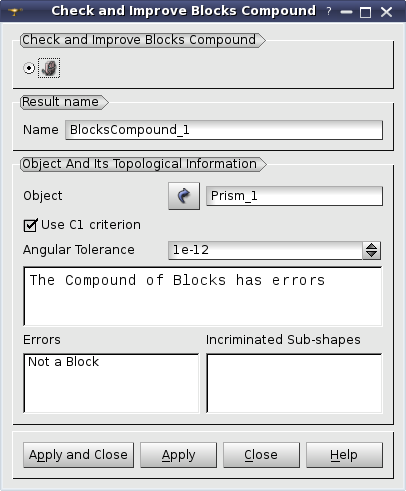This operation checks whether a shape is a compound of glued blocks and improves the shape to include only valid blocks.
To be considered as a compound of blocks, the given shape must satisfy the following conditions:
- Each element of the compound should be a Block, i.e. have 6 quadrangle faces;
- Each quadrangle face should have one wire with four edges. If there are more than four edges in a single wire and C1 continuity mode is switched on, a face is quadrangular if it has four bounds with C1 continuity.
- Blocks can be connected only via an entire quadrangle face or an entire edge;
- The compound should be connected;
- Each couple of connecting quadrangle faces should be glued.
In this dialog:
- Object - the checked object. Selection button allows picking it in the viewer or in the object browser.
- Use C1 criterion - option switches on/off the C1 continuity mode.
- Angular Tolerance - angular tolerance to check C1 continuity between neighbor edges in a wire.
- Errors list informs of possible errors, for example:
- Not a block;
- Not glued;
- Not connected;
- Extra or degenerated edge.
- Incriminated Sub-shapes field outputs the list of sub-shapes that cause problem.
- Apply and Apply and Close buttons launch the improvement process and publish the result shape, which includes valid blocks only. The algorithm tries to:
- remove seam and degenerated edges from surfaces of revolution;
- re-approximate surfaces to exclude singularities on boundaries;
- unite edges and faces;
- glue faces.
TUI Command: geompy.CheckCompoundOfBlocks(Compound, theIsUseC1 = False, theAngTolerance = 1.e-12). Checks if the shape is a valid compound of blocks. If it is true, then the validity flag is returned, and encountered errors are printed in the python console.
See also a TUI example.
